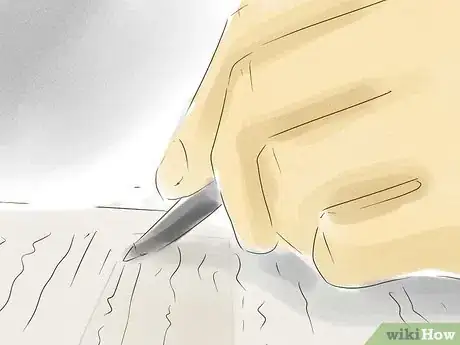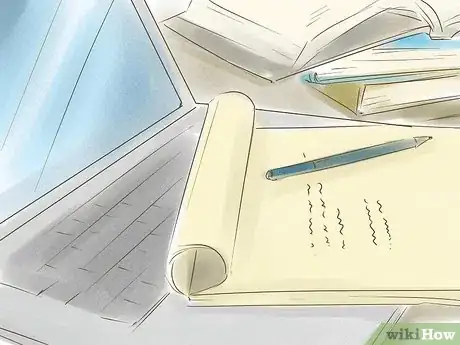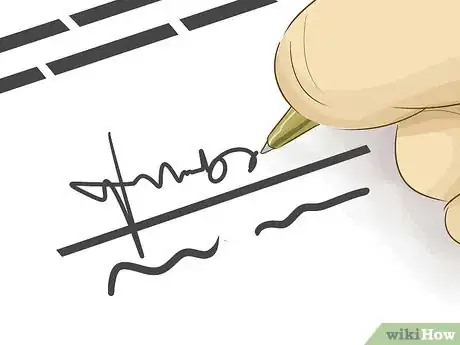This article was written by Jennifer Mueller, JD. Jennifer Mueller is an in-house legal expert at wikiHow. Jennifer reviews, fact-checks, and evaluates wikiHow's legal content to ensure thoroughness and accuracy. She received her JD from Indiana University Maurer School of Law in 2006.
There are 11 references cited in this article, which can be found at the bottom of the page.
This article has been viewed 32,354 times.
Litigation is time-consuming, stressful, and expensive – which explains why approximately 95 percent of all pending lawsuits are settled out of court before trial.[1] If you filed the lawsuit, you may end up with less money through a settlement than you would get if you took the case to trial. However, a settlement provides more certainty and more control over the final outcome for both parties. If you're involved in litigation – whether because you've filed a lawsuit or because someone is suing you – reaching a settlement may be easier than you think. As with any situation where your legal rights and substantial sums of money may be at stake, you should consider consulting an attorney before you begin settlement negotiations or agree to a settlement.
Steps
Engaging in Direct Negotiations
-
1Calculate your settlement demand or offer. Review the evidence at hand and determine what damages are likely to be proven at trial, then set a settlement range that takes the costs of litigation into consideration.
- Leave room for negotiation when you calculate your settlement amount by placing your ideal amount in between the bottom line and the maximum. You should expect that the other side is going to send a counter-offer, so you shouldn't lead negotiations with the lowest dollar amount you are willing to accept.
- For example, suppose you are a plaintiff – the person who filed the lawsuit – seeking money for medical bills and damage to your car after an auto accident. Your medical bills and the cost to fix your car totaled $100,000. However, you anticipate that you may have future medical bills, and you also have lost wages. If $100,000 is the least you are willing to accept, avoid presenting this number to the other side for settlement. Instead, calculate a number two or three times that and allow the other side to negotiate down.
- As time goes on, make sure you adjust your range to take any additional costs into account. For example, if you have to hire an attorney or attend a deposition, those costs should be included in your settlement amount.
-
2Write a letter outlining your position. Once you've determined an initial amount to offer, write a letter to the other side making your offer and briefly explaining the reasons you think that amount is fair.
- Before you write your letter, make sure you've thoroughly evaluated the case and understand the elements of the claim. If you see weaknesses in the other side's case, you can point them out in your letter as reasons for settlement.[2]
- If you're suing a large corporation, the prospect of an open trial could be a public relations nightmare. You can raise this specter in your letter to further improve the chances of your demand being accepted, particularly if you indicate a willingness to keep all aspects of the settlement confidential.[3]
Advertisement -
3Wait for a response. Give the other side a deadline to respond to your offer, and follow-up to make sure the deadline is met.
- If you're the plaintiff and have not yet filed a lawsuit, for example, you might indicate that the other side has 10 days to accept your settlement demand or you will file suit. Such a statement is more powerful if you draft your complaint ahead of time and attach the unsigned draft to your letter.
-
4Evaluate the counter-offer. Figure out where the other side's offer fits in your settlement range and adjust your position accordingly.
- In many cases, the other side will send you an offer and indicate that is the most they're willing to consider to settle the claim. This may happen if, for example, you are an accident victim suing an insurance company. In this situation, you may be unable to settle your case through direct negotiations, particularly if the numbers are far apart or if the number the other side provides is below the minimum amount you're willing to accept.
- If you are the person being sued, use projected costs of litigation to drive the other side's offer down. If it is early in pre-trial litigation, you can estimate how much it would cost the plaintiff to pursue her case and argue that the settlement is saving her those costs.
- Litigation involves numerous expenses, including discovery expenses such as depositions. If the case goes to trial, each party may incur additional expenses such as fees for expert witnesses and travel expenses. By settling out of court, these expenses are reduced if not eliminated.[4]
- Particularly if you are a plaintiff in a personal injury case, the uncertainty of a jury verdict can work in your favor. Juries tend to be biased towards plaintiffs, especially when the defendant is an insurance company or a large corporation.[5]
- If you don't already have an attorney working with you on your case, you might consider consulting an attorney with experience handling your type of claim to evaluate the strengths and weaknesses of your case.[6]
- If key elements of your case would prove difficult to prove at trial, it may be to your advantage to settle – even for a lesser amount than you want – to avoid exposing those weaknesses to the other side.
-
5Decide how to respond. If the other side hasn't accepted your settlement offer or demand, use your evaluation to craft your response.
- Keep your settlement range in mind, particularly if you decide to adjust your number to counter theirs. For example, if you were the plaintiff and initially demanded $100,000 to settle your claim and the company you're suing sent a counter-offer for $40,000, you might come down to $80,000.
- If you're going to adjust your amount, provide solid reasons to explain your adjustment. For a downward adjustment, make it clear what factors you're removing from consideration. If you're a defendant making an upward adjustment, let the plaintiff know which points of theirs you considered persuasive in re-evaluating your offer.
-
6Get any agreement in writing. In addition to the settlement amount, your written agreement should also include any other terms or conditions of the settlement.
- Often the settlement agreement includes a clause mandating that details about the agreement, including the settlement amount, are to be kept secret.[7] While large corporations often favor these non-disclosure or confidentiality clauses from a public relations standpoint, review the clause carefully so that you understand what you can and cannot say about your case, and what the penalties are for violating that confidentiality.
- You might consider having an attorney review your settlement agreement before you sign it – especially if there are terms or conditions that you don't entirely understand. This is particularly true if you are the plaintiff, since a settlement agreement often contains a clause in which you waive your right to sue the defendant again for any claims arising out of the same incident.
Using Mediation
-
1Select a mediator. The clerk of court's office may have a list of mediators that are approved by the court or local bar association.[8]
- Mediators are neutral third parties who facilitate both parties in coming to an agreement on their own. Mediators don't make any decisions about the case or represent either party.[9]
-
2Gather relevant information and documentation. Before your mediation appointment, pull together copies of any documentation you have of costs you've incurred or expenses you anticipate.
- In addition to your own bills, you might ask for information from the other side if it is something you need to evaluate your case and plan for mediation. For example, if you are suing an insurance company for injuries you sustained in a car accident, it's important for you to know the policy limits of the defendant's insurance coverage.[10]
- Some mediators allow the parties to make requests for information that are handled through the mediator. Others require each side to put together a packet of relevant documents prior to mediation which will be shared with the other side.
-
3Prepare your proposals and strategy. Using the evidence at your disposal and other information you've gathered, make lists of issues you expect to encounter and strategies to resolve them.
- Although mediation is less formal than a trial, you should have your case and evidence organized and ready to present as though you were preparing for trial.[11] The outcome of mediation depends, to a large extent, on how seriously all parties take the process.
-
4Consider consulting an attorney. Although you don't need an attorney to represent you during mediation proceedings, an attorney can help you calculate your settlement range or provide you with advice on mediation strategy.
- An attorney with experience handling the type of claim you have also may be better able to negotiate on the fly once the mediation process begins. Additionally, you should consider using an attorney if you anticipate the other side will have one. This is the case particularly if you are suing a large corporation, which doubtless will have an entire legal team there to represent its interests.[12]
-
5Participate in mediation. Arrive on the day of your appointment with an open mind and a non-confrontational attitude.
- The mediator introduces herself and the parties, and explains what the goals are for the session. Then she gives each side an opportunity to describe the dispute and its effects.[13]
- Following these statements, the mediator either will facilitate a joint discussion between you and the other side, or will separate the parties and pass offers and other points back and forth with the goal of coming to a compromise on the claim.[14]
-
6Review the agreement. If you arrive at a settlement over the course of mediation, make sure you understand all the terms of the written agreement.
Getting Court Approval
-
1Provide notice of the settlement to the court. Check your court rules to determine the procedure for notifying the court that you've settled your case.
- In most cases, if you filed a complaint or petition to initiate a civil action, you must inform the court if you've settled the entire case. You also may be required to notify the court immediately if you've arrived at a partial settlement of your case.[17]
- The court may have deadlines for notice or different rules for notice depending on when a hearing or trial is scheduled in your case. For example, you must provide oral and written notice to all parties and the court if you have a case pending in California and there's a hearing scheduled within 10 days.[18]
-
2Sign your settlement agreement. You may wish to have all parties sign the settlement agreement in the presence of a notary.
- Once the agreement is signed, make copies for all parties – the clerk will keep the original agreement for the court's files.
-
3File your motion for dismissal. Typically, the plaintiff must file a motion asking the court to dismiss the case because it has been settled.[19]
- The clerk of court or your local legal aid office may have forms you can use to draft your motion for dismissal. If you cannot find a form, you also may be able to find a similar motion filed in another case to use as a guide when you write and format your own.
- If you are filing a motion for dismissal, you typically must attach your settlement agreement as an exhibit. Check your local court's rules to find out if the judge will approve the settlement at the same time he grants your motion to dismiss.
-
4File your settlement agreement with the court. Take your settlement agreement to the court where the original lawsuit was filed.
- Even if you've settled your case before a lawsuit was ever filed, you usually can take the settlement agreement to the court and have it approved by a judge.[20]
- Getting court approval of your settlement means the agreement is enforceable in the same way a court order issued by a judge would be.
- You must pay a filing fee to have your settlement agreement approved. Typically your fees will be between $100 and $200.[21] If you cannot afford the filing fees, you may be able to fill out an application for a waiver at the clerk's office.
-
5Attend your hearing. The judge may order a hearing to ask you basic questions about the settlement before she signs off on it.
- At the hearing, the judge likely will ask if you understand the terms of the settlement and if you agreed to it. The judge also may ask questions to determine that you are legally capable of consenting to the settlement.
- In some cases such as wrongful death claims or if the plaintiff is a minor, federal and state law may mandate the settlement be approved by a judge before it can be considered valid.[22]
- Court approval also may be required in divorce cases, particularly if there are child support or child custody issues involved.[23]
References
- ↑ http://thelawdictionary.org/article/what-percentage-of-lawsuits-settle-before-trial-what-are-some-statistics-on-personal-injury-settlements/
- ↑ http://injury.findlaw.com/accident-injury-law/resolution-before-trial-settlement.html
- ↑ http://injury.findlaw.com/accident-injury-law/resolution-before-trial-settlement.html
- ↑ https://www.lawyers.com/legal-info/research/to-settle-or-not-to-settle-that-is-the-question.html
- ↑ http://thelawdictionary.org/article/what-percentage-of-lawsuits-settle-before-trial-what-are-some-statistics-on-personal-injury-settlements/
- ↑ http://injury.findlaw.com/accident-injury-law/resolution-before-trial-settlement.html
- ↑ https://www.lawyers.com/legal-info/research/to-settle-or-not-to-settle-that-is-the-question.html
- ↑ http://www.courts.ca.gov/12434.htm
- ↑ http://www.courts.ca.gov/selfhelp-adr.htm
- ↑ http://injury.findlaw.com/accident-injury-law/resolution-before-trial-settlement.html
- ↑ http://www.nolo.com/legal-encyclopedia/mediation-six-stages-30252.html
- ↑ http://www.nolo.com/legal-encyclopedia/mediation-do-you-need-lawyer-29974.html
- ↑ http://www.nolo.com/legal-encyclopedia/mediation-six-stages-30252.html
- ↑ http://www.nolo.com/legal-encyclopedia/mediation-six-stages-30252.html
- ↑ http://www.nolo.com/legal-encyclopedia/mediation-six-stages-30252.html
- ↑ http://www.nolo.com/legal-encyclopedia/mediation-six-stages-30252.html
- ↑ http://www.courts.ca.gov/cms/rules/index.cfm?title=three&linkid=rule3_1385
- ↑ http://www.courts.ca.gov/cms/rules/index.cfm?title=three&linkid=rule3_1385
- ↑ http://www.courts.ca.gov/cms/rules/index.cfm?title=three&linkid=rule3_1385
- ↑ http://www.courts.ca.gov/selfhelp-adr.htm
- ↑ https://circuitclerk.nashville.gov/circuit/circuitfees.asp
- ↑ https://www.law.cornell.edu/cfr/text/32/536.63
- ↑ http://family.findlaw.com/divorce/settlement-agreements-and-court-approval.html




































































